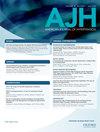Study on the Correlation Between Cerebral Vascular Variation and Hypertension
IF 3.2
3区 医学
Q2 PERIPHERAL VASCULAR DISEASE
引用次数: 0
Abstract
OBJECTIVE To investigate the association between cerebral vascular variation and hypertension in adults. METHODS Using a cross-sectional study, the current and retired employees of Kailuan Group who participated in the physical examination of Kailuan General Hospital and underwent magnetic resonance examination in 2020–2022 were taken as the observation objects, and a total of 1,029 people finally met the inclusion and exclusion criteria. The observation objects were divided into 4 groups: no cerebral vascular variation, only vertebral artery hypoplasia (VAH), only incomplete posterior Circle of Willis (ipCoW), and combined variations (VAH + ipCoW). Binary logistic regression models were used to explore the effects of different types of cerebral vascular variation on hypertension. RESULTS The mean age of the study population was 55.2 ± 11.4 years. The percentages in no cerebral vascular variations, VAH only, ipCoW only, and combined variations groups were 21.1%, 11.5%, 46.8%, and 20.6%, respectively. Using hypertension as the dependent variable and cerebral vascular variation type as the independent variable, and adjusting for multiple confounders, the results showed that the presence of both VAH and ipCoW was positively associated with hypertension risk (OR = 2.410, 95% CI = 1.401–4.146). Stratified analysis showed that the association was more pronounced in people younger than 55 (OR = 4.437, 95% CI = 1.891–10.406), whereas no significant association was found in people older than 55 (P > 0.05). CONCLUSIONS There is a positive correlation between cerebral vascular variation and hypertension, and this association is predominantly observed in the younger population.脑血管变异与高血压之间的相关性研究
目的 探讨成人脑血管变异与高血压的关系。方法 采用横断面研究,以2020-2022年参加开滦总医院体检并进行磁共振检查的开滦集团在职和退休职工为观察对象,最终符合纳入和排除标准的共1029人。观察对象分为4组:无脑血管变异、仅椎动脉发育不良(VAH)、仅不完全威利斯后环(ipCoW)和合并变异(VAH + ipCoW)。采用二元逻辑回归模型探讨不同类型的脑血管变异对高血压的影响。结果 研究对象的平均年龄为 55.2 ± 11.4 岁。无脑血管变异组、仅 VAH 组、仅 ipCoW 组和合并变异组的百分比分别为 21.1%、11.5%、46.8% 和 20.6%。以高血压为因变量,脑血管变异类型为自变量,并对多种混杂因素进行调整后,结果显示,同时存在 VAH 和 ipCoW 与高血压风险呈正相关(OR = 2.410,95% CI = 1.401-4.146)。分层分析表明,这种关联在 55 岁以下人群中更为明显(OR = 4.437,95% CI = 1.891-10.406),而在 55 岁以上人群中未发现显著关联(P &p;gt;0.05)。结论 脑血管变异与高血压之间存在正相关,这种关联主要出现在年轻人群中。
本文章由计算机程序翻译,如有差异,请以英文原文为准。
求助全文
约1分钟内获得全文
求助全文
来源期刊

American Journal of Hypertension
医学-外周血管病
CiteScore
6.90
自引率
6.20%
发文量
144
审稿时长
3-8 weeks
期刊介绍:
The American Journal of Hypertension is a monthly, peer-reviewed journal that provides a forum for scientific inquiry of the highest standards in the field of hypertension and related cardiovascular disease. The journal publishes high-quality original research and review articles on basic sciences, molecular biology, clinical and experimental hypertension, cardiology, epidemiology, pediatric hypertension, endocrinology, neurophysiology, and nephrology.
 求助内容:
求助内容: 应助结果提醒方式:
应助结果提醒方式:


